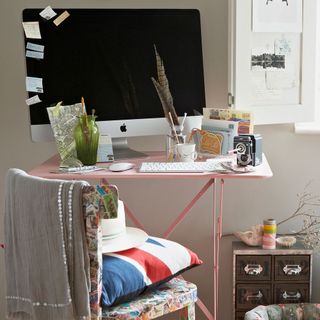The easiest way to be more productive working from home – over the coming weeks
Neuroscientist's top tips including lighting your home work space for shorter winter days
Now the daylight hours are shorter and nights are longer, the prospect of another lockdown feels more gloomy. Dyson's neuroscientist Dr Karen Dawe shares her tips for using light around the home to creating a more productive working environment from home this winter.
Related: Experts reveal how to save money on heating bills as the cold weather sets in
It's startling to see how the right light can improve our focus, as well as our general wellbeing during the darker months.
Easy ideas: how to be productive working from home

1. Maintain a daylight routine
Make the most of any natural light. 'Daylight is the gold standard when it comes to providing the right light for your tasks throughout the day. We have evolved to live and work under daylight’s changing brightness and colour temperature, regulated by cycles of day and night' Dr Karen explains. 'Daylight makes us feel more alert and is also the main signal to our body clock.' Karen explains how this influences the inner workings of our whole body including our metabolism and our activity patterns.
She suggests, 'Kick-start your day with a walk outside. This burst of early morning daylight exposure will anchor your body clock to the pattern of local daylight. Signalling that the day has begun and providing a subconscious schedule to your day.'
2. Zone a designated work space with light

'Light plays an important role in signalling that a particular part of the room has a specific purpose' explains Dr Karen. 'While building regulations make sure that office environments provide adequate levels of light, lighting in home offices is often overlooked.'
'Take control of the lighting around you. Consider how light falls around the entire room, not just directly around the light fitting' she suggests.
Going on to say 'Be conscious of the position of lights. Natural light coming through windows or spotlights reflecting off a computer screen could cause glare and eye strain, making it harder to focus.'
3. Choose the right light format for your activity
'Our research shows that people tend to use their home lighting in four ways' Dr Karens reveals. 'Indirect light for general illumination, task light for high-precision work, feature light to accent features like artwork, and ambient light for a soft relaxing glow in the evening.'
'Although countless types of lighting is found in the average home, each light typically only does one thing' she says. 'Ensure you have the right level of light for your task - if you want a cosy dim light to read under, make sure it still delivers enough light so you don’t get eyestrain.'
3. Take regular screen breaks

'We all want to stay focused when working from home, but it’s vital to give your eyes rest' advises Dr Karen. 'Forcing the eye to concentrate on a small region for a prolonged period of time, by reading a book or using a computer screen, often fatigues the eye muscles – leading to eye strain.'
'Without realising it, the screens that we use are often either too bright or not bright enough, causing glare. We can tolerate a degree of glare, flicker and eye strain, but working for eight hours a day under these conditions is really straining on the muscles around your eyes' she warns.
In addition to taking regular rests, it's advisable to adjust the brightness of your devices to provide a more comfortable light.
5. Give your eyes the light they need

'As we get older our eyes change. The muscles that control pupil size get weaker and let less light in, and the lens hardens' Dr Karen explains. 'These changes mean that, according to the IES, people over 65 need four times the amount of light compared to someone who is under 25.' So be mindful of the amount of light your eyes need, especially as the darker nights draw in.
Related: The key lighting trends for autumn – to illuminate the darker months ahead
'Each cell in our body has its own 24 hour rhythm and this clock is actually regulated by light and by darkness' explains Dyson's neuroscientist Dr Karen Dawe.
'Our body clocks have evolved under the daily pattern of daylight. In fact almost all physiological functions from protein production and our metabolism to sleep patterns are under the control of the body clock. Daylight Savings Time is a change in our social clock. But not our body clock and not the environmental clock such as the sun rising at dawn. It is vital now more than ever that we understand and take control of our daily light diet.'
Get the Ideal Home Newsletter
Sign up to our newsletter for style and decor inspiration, house makeovers, project advice and more.
Tamara was Ideal Home's Digital Editor before joining the Woman & Home team in 2022. She has spent the last 15 years working with the style teams at Country Homes & Interiors and Ideal Home, both now at Future PLC. It’s with these award wining interiors teams that she's honed her skills and passion for shopping, styling and writing. Tamara is always ahead of the curve when it comes to interiors trends – and is great at seeking out designer dupes on the high street.
-
 How to hide an extractor fan for a sleek, stylish and out-of-sight kitchen scheme
How to hide an extractor fan for a sleek, stylish and out-of-sight kitchen schemeExtractor fans are necessary but not always chic - here's how to make them more aesthetically pleasing
By Amelia Smith
-
 How to clean sofa cushions without using any nasty chemicals in the process
How to clean sofa cushions without using any nasty chemicals in the processIt couldn’t be simpler
By Lauren Bradbury
-
 How to grow a chamomile lawn for a sweet-smelling (and beautiful) alternative to traditional grass
How to grow a chamomile lawn for a sweet-smelling (and beautiful) alternative to traditional grassFancy a stunning lawn with a wildflower twist? It's time to give chamomile a go
By Kayleigh Dray